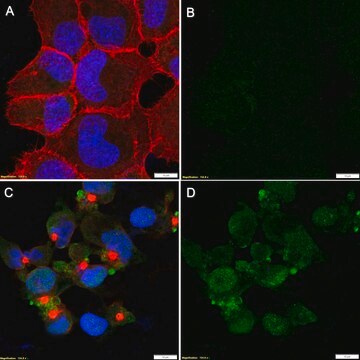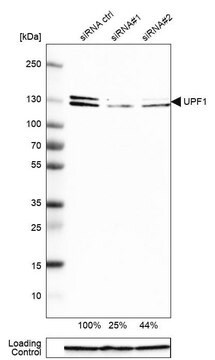07-1016
Anti-phospho-Upf1 (Ser1127) Antibody
from rabbit, purified by affinity chromatography
Sinónimos:
Regulator of nonsense transcripts 1, ATP-dependent helicase RENT1, Nonsense mRNA reducing factor 1, NORF1, Up-frameshift suppressor 1 homolog, hUpf1
About This Item
Productos recomendados
origen biológico
rabbit
Nivel de calidad
forma del anticuerpo
affinity isolated antibody
tipo de anticuerpo
primary antibodies
clon
polyclonal
purificado por
affinity chromatography
reactividad de especies
mouse, human
reactividad de especies (predicha por homología)
chicken (based on 100% sequence homology), zebrafish (based on 100% sequence homology), yeast (based on 100% sequence homology), bovine (based on 100% sequence homology), rat (based on 100% sequence homology)
técnicas
immunoprecipitation (IP): suitable
western blot: suitable
Nº de acceso NCBI
Nº de acceso UniProt
Condiciones de envío
wet ice
modificación del objetivo postraduccional
phosphorylation (pSer1127)
Información sobre el gen
human ... UPF1(5976)
Descripción general
Especificidad
Inmunógeno
Aplicación
Peptide Inhibition Analysis: A 1:1,000 dilution from a representative lot blocked phospho-Upf1 (Ser1127) in NIH3T3 treated with Calyculin A and Okadaic Acid.
Immunoprecipitation Analysis: 5 µg from a representative lot immunoprecipitated phospho-Upf1 (Ser1127) in NIH3T3 treated with Calyculin A and Okadaic Acid.
Calidad
Western Blotting Analysis: A 1:1,000 dilution of this antibody detected phospho-Upf1 (Ser1127) in 10 µg lysate from NIH3T3 treated with Calyculin A (50 nM) and Okadaic Acid (500 nM) for 30 minutes.
Descripción de destino
Otras notas
¿No encuentra el producto adecuado?
Pruebe nuestro Herramienta de selección de productos.
Código de clase de almacenamiento
12 - Non Combustible Liquids
Clase de riesgo para el agua (WGK)
WGK 1
Punto de inflamabilidad (°F)
Not applicable
Punto de inflamabilidad (°C)
Not applicable
Certificados de análisis (COA)
Busque Certificados de análisis (COA) introduciendo el número de lote del producto. Los números de lote se encuentran en la etiqueta del producto después de las palabras «Lot» o «Batch»
¿Ya tiene este producto?
Encuentre la documentación para los productos que ha comprado recientemente en la Biblioteca de documentos.
Nuestro equipo de científicos tiene experiencia en todas las áreas de investigación: Ciencias de la vida, Ciencia de los materiales, Síntesis química, Cromatografía, Analítica y muchas otras.
Póngase en contacto con el Servicio técnico








